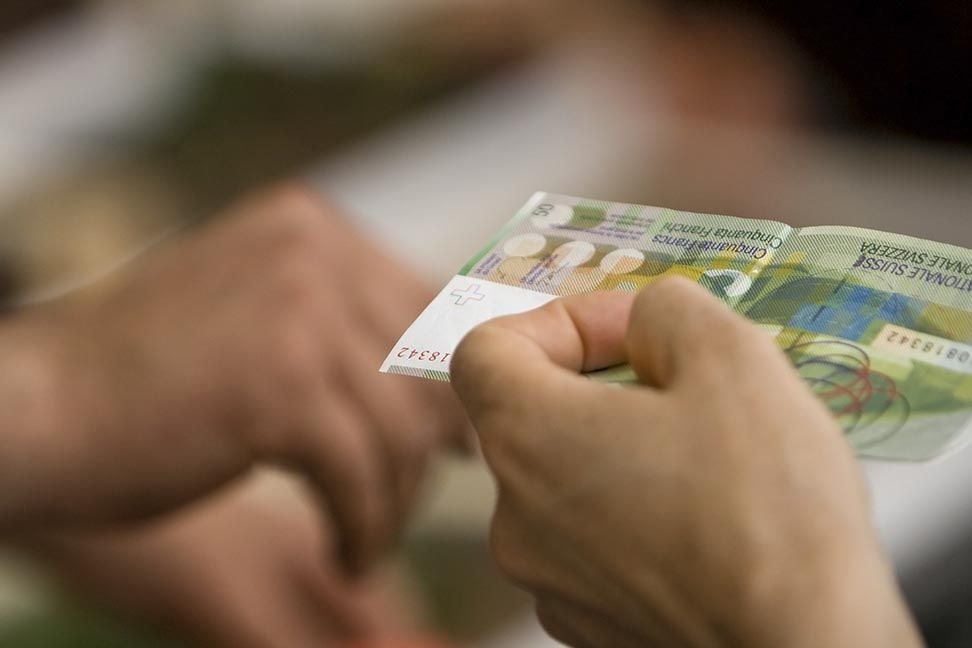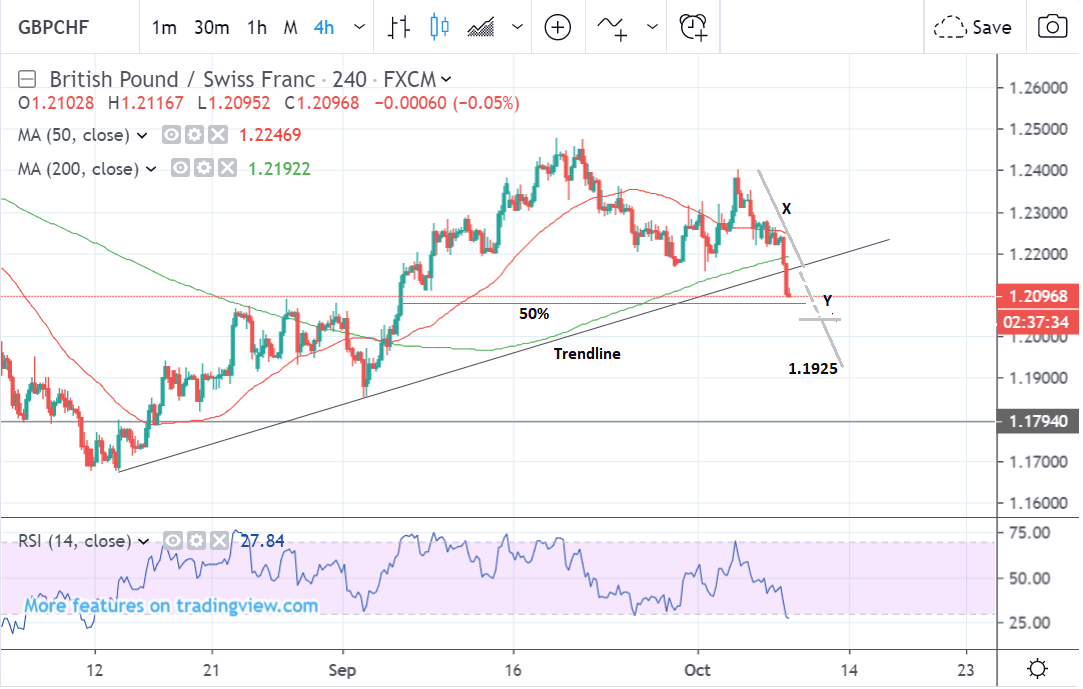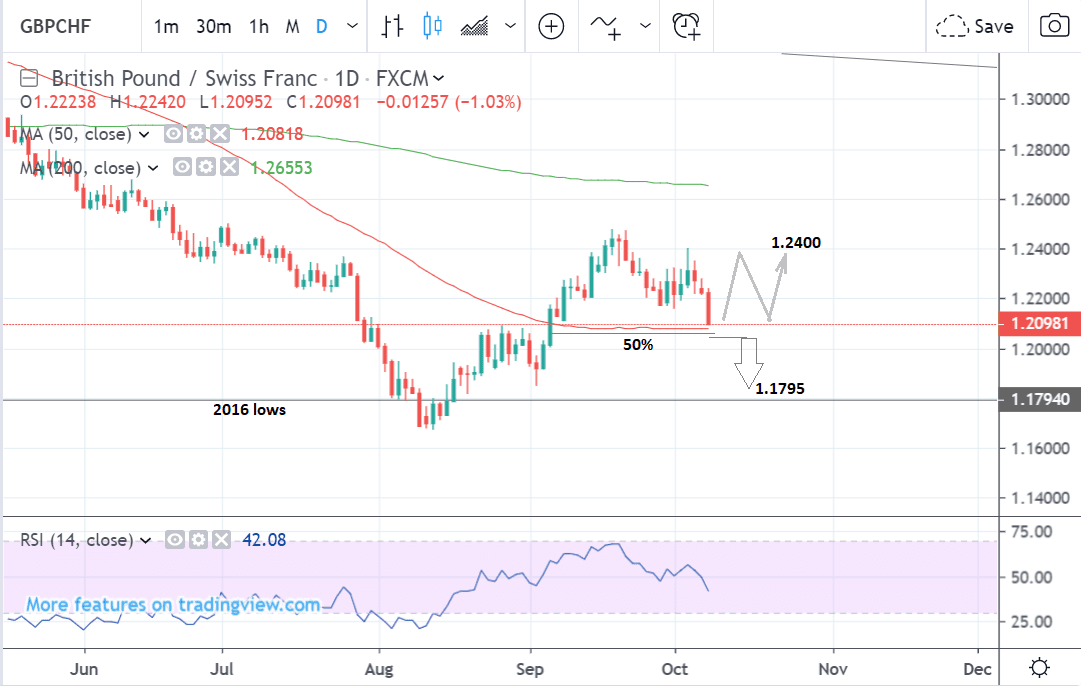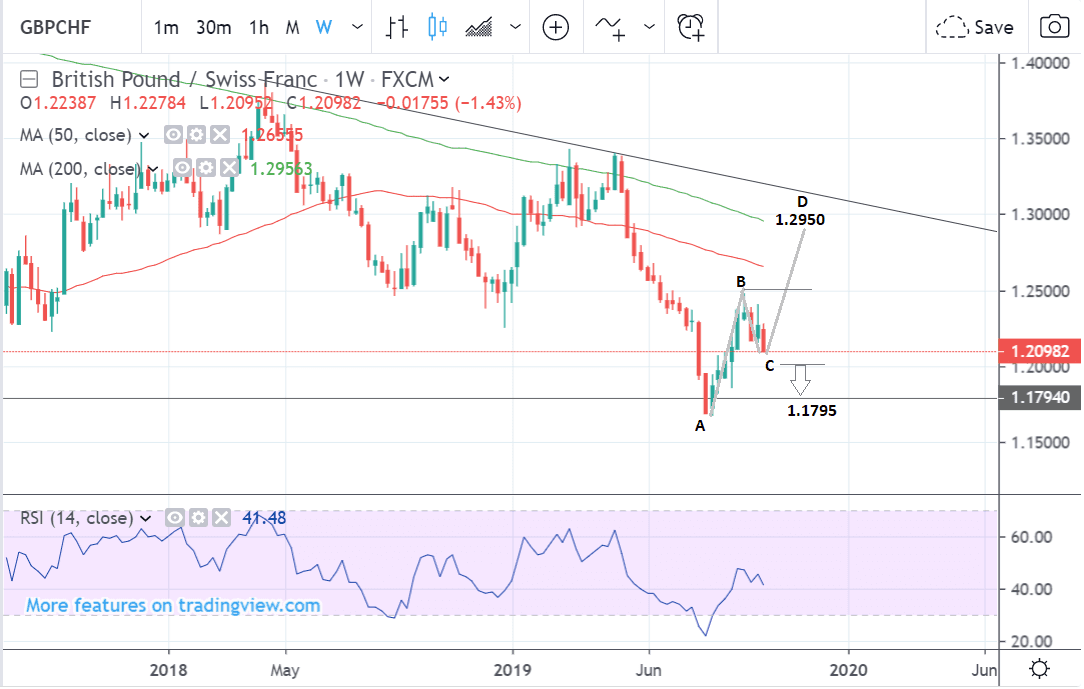Pound-Franc Rate Reaches Support Zone Raising Possibility of Bounce

Image © Adobe Images
- GBP/CHF falls to support from 50-day MA and midpoint
- Substantial directional move required to confirm bias
- Main driver of Swiss Franc trade talks
The Pound-to-Franc exchange rate is trading at around 1.2142 at the time of writing, with a slight rebound coming on the back of tough start to the week that has seen it fall from 1.2278.
Studies of the charts suggest the pair is reaching a strong support zone that might offer some near-term relief, however confidence in Sterling's ability to resist the Franc's advances is low.
The 4 hour chart - used to determine the short-term outlook, which includes the coming week or next 5 days - shows the exchange rate breaking below a trendline and accelerating lower.
The trendline break indicates a probable continuation down to a target of an equal distance as the move immediately prior to the trendline (labeled X).
Such a move extrapolated after the break (Y) could see the pair reach a downside target at 1.1925.
The pair still needs to break below several tough support levels, however, before it comes close to reaching the downside target.
These include the midpoint of the previous rally, or 50% Fibonacci retracement, and the 50-day moving average (MA), both situated in the upper 1.20s.
A break below 1.2025 would be required, therefore, to provide stronger confirmation this support floor had been broken and the pair was on its way down to the next target at 1.1925.
The daily chart shows the pair selling-off steeply down to a tough support zone composed of the 50% retracement of the previous rally and the 50-day moving average (MA) which is at the same level in the late 1.20s.
Large MAs such as the 50-day often act as a barrier preventing more downside.
From the current position there are various possible scenarios which might unfold.
Given the steepness of the downtrend the pair could break through the support level and continue even lower, towards a target at 1.1795 eventually.
Alternatively, the pair could use the support zone as a base from which to recover and rise up to a target at 1.2400 at the level of the October 3 highs.
The daily chart is used to give an indication of the outlook for the medium-term, defined as the next week to a month ahead.
The weekly chart - which gives a longer-term overview - shows how the pair has rebounded from the June lows and then pulled-back.
The initial move up during the summer was quite steep and this could indicate that the current bearish sell-off is merely a correction of a much stronger overall up-cycle.
If so the pair might be forming an ABCD pattern higher which will eventually start to rise in a final C-D leg up to a possible target at 1.2950 and the 200-week moving average (MA).
Alternatively, it is possible the move down could continue to the 1.1795 lows as suggested on the daily chart, however, this would require a break substantially below major support to confirm.
Time to move your money? Get 3-5% more currency than your bank would offer by using the services of a specialist foreign exchange specialist. A payments provider can deliver you an exchange rate closer to the real market rate than your bank would, thereby saving you substantial quantities of currency. Find out more here.
* Advertisement
The Swiss Franc: Key Factors to to Watch
The main driver of the Swiss Franc in the near term is the state of the global economy and investor risk appetite.
The Swiss Franc is considered a safe-haven currency which rises and falls largely as a result of in and outflows of capital as investors respond to broader market conditions. The Franc is often used to fund investments when markets are bullish, and these investments are reversed back into Francs when markets turn sour.
This means that when concerns around the global economy intensify the Swissie actually rises, and this is looking increasingly like it might be the case over the next 5 trading days.
In the short-term, the main driver of investor risk appetite is likely to be the success of trade talks between China and the U.S. which begin on Thursday, October 10.
The general consensus, however, is that talks will probably not result in anything constructive.
The main problem is that China has already excluded certain key issues from discussion, including intellectual property, technological transfer and state subsidies, and these are areas the U.S. wants covered to make a deal.
The other problem is that judging from previous comments, Donald Trump does not want anything less than a fully comprehensive deal.
“If the deal is not going to be 100% for us, then we’re not going to make it,” said Trump last Friday.
Another potential issue could be the reaction of the Chinese authorities to protests in Hong Kong, after Trump said: “If anything happened bad, I think that would be a very bad thing for the negotiation. I think politically it would be very tough.”
If the Chinese decide to crack down on the protesters it could jeopardise a deal.
One possible area where negotiators might make a breakthrough could be up-and-coming tariff increases scheduled for October 15.
“A best-case scenario from this week’s talks” would be for the US to agree to delay a proposed increase in tariffs on October 15 which would increase duties on $250bn of chinese imports from 25% to 30%,” says Jason Wong, an analyst at BNZ Bank.
Another positive development on the trade front is that the U.S. has agreed to lift a proposed ban on U.S. investors buying Chinese stocks.
The other major issue driving the Swissie recently has been the ruling on Swiss Franc mortgages by the European Court of Justice (ECJ) which will see many mortgages sold in Poland converted back into Polish Zloty mortgages.
The ruling temporarily devalued the Swissie last week but does not appear to be influencing it currently.
The impact of copy-cat rulings in other Eastern European countries such as Romania and Hungary, whose banks also took part in the practice are likely to mostly impact their exchange rates rather than majors.
Time to move your money? Get 3-5% more currency than your bank would offer by using the services of a specialist foreign exchange specialist. A payments provider can deliver you an exchange rate closer to the real market rate than your bank would, thereby saving you substantial quantities of currency. Find out more here.
* Advertisement



